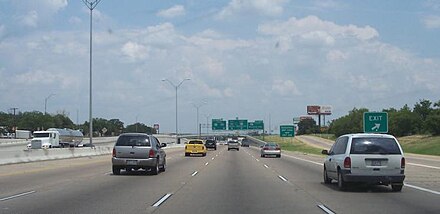North Texas is a term used primarily by residents of the Dallas–Fort Worth metroplex[7][8] to refer to a geographic area of Texas, generally considered to include the area south of Oklahoma, east of Abilene, west of Paris, and north of Hillsboro.[9] Definitions of the region usually don't include the sparsely populated Panhandle of Texas, which is the northernmost region of Texas bordered by New Mexico to the west and Oklahoma to the north and east.[10][11]
Today, North Texas is centered upon the Dallas–Fort Worth metroplex, the largest metropolitan area in Texas and the Southern United States. People in the Dallas and Fort Worth areas sometimes use the terms Metroplex, DFW, and North Texas interchangeably. However, North Texas refers to a much larger area that includes many northern rural counties along the Red River of the South border.[12]
Indigenous tribes in North Texas included the Caddo, Tawakoni, Wichita, Kickapoo, and Comanche.[13][14][15] With European colonization, Mexican independence, and Texan independence and annexation to the United States, many of these tribes experienced demographic decline through relocation, slavery, etc. Since European colonization and the independence movements, the North Texas area was settled and most notably developed the cities of Dallas and Fort Worth.
The North Texas climate is subtropical with hot summers. It is also continental, characterized by a wide annual temperature range. Average annual precipitation also varies considerably, ranging from less than 28 to more than 48 inches (700–1200 mm). Severe storms are frequent in the spring and summer, as the area lies in the southern section of "tornado alley".
South is the prevailing wind direction, and southerly winds are frequently high and persist for several days. Strong northerly winds often occur during the passage of cold fronts.
Winters can be mild, but northers occur about three times each month, and often are accompanied by sudden drops in temperature. In Dallas, a record-setting 12.8 inches of snow fell in February 2010. Periods of extreme cold that occasionally occur are short-lived, so that even in January mild weather occurs frequently.[16]
The highest temperatures of summer are associated with fair skies, and moderate to high humidities. Characteristically, hot spells in summer are broken into three- to five-day periods by thunderstorm activity. There are only a few nights each summer when the low temperature exceeds 80 °F (27 °C). Summer daytime temperatures frequently exceed 100 °F (38 °C). Air conditioners are recommended for maximum comfort indoors and while traveling via automobile.
Throughout the year, rainfall occurs more frequently during the night. Usually, periods of rainy weather last for only a day or two, and are followed by several days with fair skies. A large part of the annual precipitation results from thunderstorm activity, with occasional heavy rainfall over brief periods of time. Thunderstorms occur throughout the year, but are most frequent in the spring and early summer months. Hail falls on about two or three days a year, ordinarily with only slight and scattered damage. Windstorms occurring during thunderstorm activity are sometimes destructive. Snowfall is uncommon.
The average length of the warm season (freeze-free period) is about 249 days. The average last occurrence of 32 °F (0 °C) or below is mid March and the average first occurrence of 32 °F or below is in late November.[17]
Although the terms "Northeastern Texas" or "North Texas" are not official state designations, the Texas State Data Center and Office of the State Demographer lists the following counties as belonging to the North Central Texas Council of Governments (NCTCOG):[18][19]
The Texas State Demographer also lists the following regional county groupings, some or all of which are often included in the informal meaning of the terms "North Texas" or "North Central Texas."
Additionally, some other Texas counties contiguous with those named above are sometimes included in the general meaning of "North Texas."
In the North Texas region there is one combined statistical area, three metropolitan areas, and seven micropolitan areas.
Metropolitan statistical areas (MSAs)

Micropolitan statistical areas (μSAs)
Metropolitan statistical areas (MSAs)
Micropolitan statistical areas (μSAs)
Micropolitan statistical Areas (μSAs)
Dallas–Fort Worth metroplex[22]
Wichita Falls metropolitan area[23]
Sherman–Denison metropolitan area[24]
The North Texas region has teams from the four major professional sports leagues. Major professional sports first came to the area in 1960, when the Dallas Cowboys began competing in the National Football League and the Dallas Texans began competing in the American Football League. (The Texans later relocated to Kansas City and became the Chiefs). In 1972, Major League Baseball's Washington Senators moved to Arlington to become the Texas Rangers, named after the statewide law enforcement agency. The National Basketball Association expanded into North Texas in 1980 when the Dallas Mavericks were added to the league. The fourth sport was added in 1993 when the Minnesota North Stars of the National Hockey League moved to Dallas, becoming the Dallas Stars.
The Major League Soccer team FC Dallas is based in Frisco, and the Dallas Wings of the WNBA plays in Arlington. The area is also home to many minor league professional teams and four colleges that compete in NCAA Division I athletics.
^- Indicates year team relocated to the area
^- Indicates year team relocated to the area
The headquarters for both the Big 12 and Conference USA are located in Irving, and the Southland Conference headquarters are in Frisco.



.jpg/440px-University_of_North_Texas_September_2015_42_(Interstate_35E).jpg)




It is a 9,000-square-mile, 13-county region that is home to 7.5 million people. North Texas is made up of 150 cities – including Dallas and Fort Worth – with 15 of those cities boasting a population of more than 100,000.
Grayson County, in north central Texas, is bordered by the Red River and by Fannin, Collin, Denton, and Cooke counties. The county seat, Sherman, which lies approximately sixty-five miles north of Dallas, is part of the Sherman-Denison Metropolitan Statistical Area.